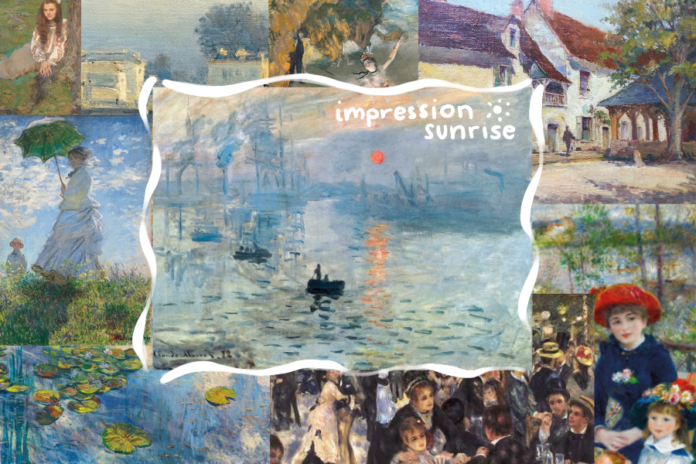Impressionist art is rebellious, intuitive and imperfect
By MAYA KORNYEYEVA — mkornyeyeva@ucdavis.edu
“Impression Sunrise,” Claude Monet’s beautifully complex debut painting, captivated me from the moment I first saw it.
Depicting a lonely boat floating on a waterway, a blazing orange sun and the plumes of industrial life in the distance, “Impression Sunrise” conveys a notion of both new beginnings and stillful foreboding through its creative mixture of warm and cool tones. The painting also offers a sense of full immersion through its depiction of light; with one glance at “Impression Sunrise,” I can imagine myself there on the water, looking out over a vast city and experiencing the first light of the rising sun as it breaks through the clouded morning mist.
Impressionism, named after Monet’s “Impression Sunrise,” is largely regarded as one of the most influential art movements in history. Springing forth from the rapid modernization of the 19th century, this style of painting is all about gentle strokes on canvas, the playful banter between light and shadow and the layering of dozens of colors to capture a sense of motion and serenity within everyday life.
Despite the contemporary respect for the movement, its birth, as with any new wave of art, was fraught with opposition. Initially met with critique and ridicule, founding artists Monet, Edgar Degas and Pierre-August Renoir (among others) persevered and became immortalized through their, at the time, revolutionary approach to capturing daily life through painting.
Even though we exist hundreds of years after this “rebellious” style of art, what impressionists brought to the table in 19th century France is not so far removed from the world of today. We can learn so much from the paintings, techniques and motivations of these talented artists: from Alfred Sisley to Cecilia Beaux.
A key feature that set impressionist artists apart was their “rough” brushwork, which was vastly different from the predominant art styles circulating France in the late 19th century. Artists like Sisley, Renoir, Monet and Degas used “broken” color, a color theory technique that involved adding a brush of color to the canvas and allowing it to set without blending it. Often, they would put two opposite colors together, filling their chosen composition with vibrancy.
From this technique, we can learn the importance of embracing imperfection in our lives. Not everything needs to be picture-perfect, and what may seem like a mistake can actually add to your overall experience and give you the opportunity to learn and improve.
“Broken” color also carries the lesson of restraint and patience; anything you do takes time and conscious effort, and it is important to trust the process and not fall into the trap of self-doubt. What may seem like chaos — for instance, two opposite colors together — can have the effect of serenity.
Along with the way impressionist artists worked with color, their asymmetrical, non-idealized figures and compositions contradicted centuries of Roman and Renaissance artistic tradition. Rather than striving for perfection, they allowed their intuition to influence their paintings and lean into a new artistic style. This “parting with tradition” is another major lesson to be gleaned from impressionism; beautiful art can be created using novel strategies and with motivations that deviate from the “norm.” Social progress is driven with the introduction of avant-garde methods, ideas and innovations, and the same can be said for the world of art.
Impressionism also encourages a symbiotic relationship with the natural world. Impressionists held a special love for the outdoors and chose to work outside whenever possible, painting in the elements and allowing themselves to be influenced by them. This method is called painting “en plein air.”
Contrary to the values of impressionists, today we are continuously driven further into the indoors. I’ve noticed that I almost never get a chance to just take a walk outside, to get away from work or classes and allow myself to reconnect with nature. I often take the natural world for granted, and impressionist artists urge us to see its beauty and experience it more frequently.
At the end of the day, you don’t have to be a painter, artist or designer: you just need to be yourself. Impressionism is all about capturing singular moments in time — snapshots of reality which are neither photorealistic nor abstract, but which reflect the mood, energy and vibrancy of a singular moment in time. Impressionism nudges you to live in the moment. So, view the world as an impressionist painter would: filled with raw feeling and an overwhelming sense of humanity.
Written by: Maya Kornyeyeva — mkornyeyeva@ucdavis.edu
Disclaimer: The views and opinions expressed by individual columnists belong to the columnists alone and do not necessarily indicate the views and opinions held by The California Aggie.





